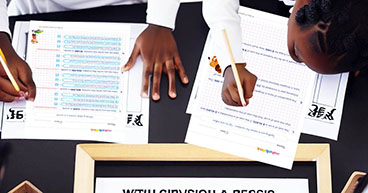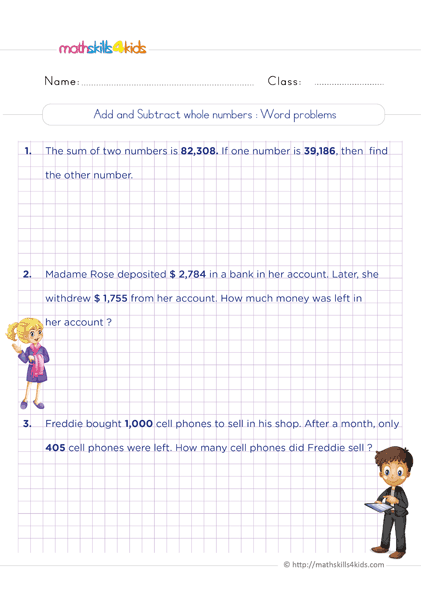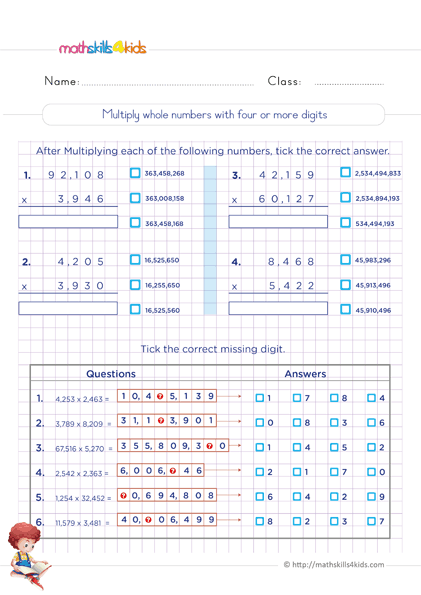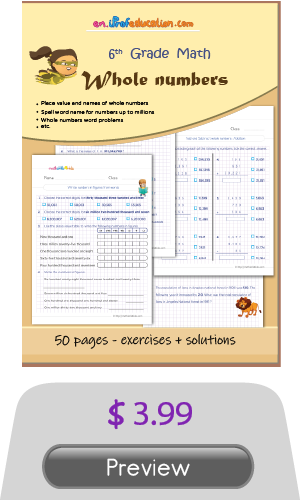Best of Operations on Whole Numbers Worksheets for Grade 6 Pdf with Answers and Explanations

Hi there, welcome to the mathSkills4Kids.com blog, where I share my passion for math and education. Today, you'll discover some original operations on whole numbers worksheets for grade 6 pdf with answers and explanations in addition, subtraction, multiplication, and division.
These worksheets are perfect for practicing and mastering the skills of adding and subtracting large numbers, as well as solving word problems involving multiplying and dividing whole numbers.
You can download them for free from the links below and print them out for your use or your students/children.
-
Multiple Choice Questions (MCQs) on operations on whole numbers worksheets for grade 6
Here are ten multiple-choice questions (MCQs) on operations on whole numbers for grade 6 for your kiddos. These questions will test their skills in addition, subtraction, multiplication, and division of large numbers, using estimation, and applying the order of operations.
-
-
What is the value of 567 + 432 - 99?
A) 900
B) 810
C) 800
D) 700 -
What is the value of 1234 - (567 + 89)?
A) 578
B) 668
C) 778
D) 888 -
What is the quotient of 144 ÷ 12?
A) 10
B) 11
C) 12
D) 13 -
What is the value of 999 - 888 + 777?
A) 888
B) 898
C) 998
D) 988 -
What is the missing factor in this equation: ___ x 9 = 81?
A) 7
B) 8
C) 9
D) 10
-
-
-
What is the product of 12 x 15?
A) 120
B) 150
C) 180
D) 200 -
What is the value of 456 + 789 - 123?
A) 1122
B) 1112
C) 1222
D) 1212 -
What is the value of 9999 + 1111 - (2222 + 3333)?
A) 5555
B) 6666
C) 7777
D) 8888 -
What is the missing divisor in this equation: 72 ÷ ___ = 9?
A) 6
B) 7
C) 8
D) 9 -
What is the simplified value of this expression: (6 x 5) ÷ (3 x 2)?
A) (30 ÷6)
B) (18 ÷10)
C) (5 ÷3)
D) (10 ÷3)
-
-
Click the links below to download operations on whole numbers for grade 6:
Multiple Choice Questions (MCQs) on operations on whole numbers for grade 6 answers and explanations
Here are multiple-choice questions (MCQs) on operations on whole numbers for grade 6 answers and explanations to help students/children to verify their work and get a better understanding of the given exercises.
Question 1:
The correct answer is B) 810.
To solve this problem, you can use the associative property of addition and subtraction, which states that you can group the numbers in any way without changing the result.
For example, you can rewrite the expression as (567 - 99) + 432, which gives 468 + 432 = 810.
Question 2:
The correct answer is A) 578.
To solve this problem, you need to apply the order of operations, which states that you must perform the operations inside the parentheses before doing anything else.
So, you have to calculate 567 + 89 first and get 656. Then, you subtract that from 1234, which gives you 578.
Question 3:
Answer: C) 12.
To find the quotient of two numbers, you divide them. So 144 ÷ 12 = 12.
-
Question 4:
The correct answer is A) 888. To solve this problem, we also need to follow the order of operations. First, we subtract 888 from 999, which gives us 111. Then, we add 777 to 111, which gives us 888.
Question 5:
Answer: C) 9.
To find the missing factor, you can use inverse operations. That means you can divide both sides of the equation by 9 to get the answer.
So ___ x 9 = 81 becomes ___ = 81 ÷ 9, which is ___ = 9.
Question 6:
Answer: C) 180.
To find the product of two numbers, you multiply them together. So 12 x 15 = 180.
Question 7:
The correct answer is B) 1112.
To solve this problem, we need to follow the order of operations.
First, we add 456 and 789, which gives us 1245. Then, we subtract 123 from 1245, which gives us 1112.
Question 8:
The correct answer is A) 5555.
To solve this problem, you can use a similar strategy as in question 2. So, you can first add (9999 + 1111) and (2222 + 3333), which makes it easier to solve.
Therefore the equation sentence becomes (11110 - 5555), which is equal to 5555.
Question 9:
Answer: C) 8.
To find the missing divisor, you can also use inverse operations. That means you can multiply both sides of the equation by ___ to get the answer.
So 72 ÷ ___ = 9 becomes 72 = ___ x 9, which means ___ = 72 ÷ 9. So, ___ = 8.
Question 10:
Answer: D) (10 ÷3).
To evaluate this expression, you need to follow the order of operations. That means you do what's inside the parentheses first, then multiply or divide from left to right.
So (6 x 5) ÷ (3 x2 ) becomes (30) ÷ (6), which is equal to (10 ÷3).
Writing Whole Numbers in Words Complete with the Missing Word Exercises for Grade 6
These Class 6 operations on whole numbers word problems with answers and explanations contain multiple real-life situations which involve addition, subtraction, multiplication, and division of whole numbers for grade 6. These problems will help your students/children to practice their arithmetic skills and also test their logical thinking.
Problem 1:
Alice has 12 books in her backpack and 8 books on her desk. She wants to donate some of her books to the school library. She decides to donate half of the books in her backpack and a quarter of the books on her desk. How many books will Alice have left after donating?
-
Solution:
To find out how many books Alice will have left, we must subtract the number of books she donated from the total number of books she had.
First, let's find out how many books she donated from her backpack and desk.
Half of 12 books is 12 ÷ 2 = 6 books.
A quarter of 8 books is 8 ÷ 4 = 2 books.
So, Alice donated 6 + 2 = 8 books in total.
Secondly, let's find out how many books Alice had before donating. We add the number of books in her backpack and on her desk to get it.
12 + 8 = 20 books.
Finally, let's find the remaining number of books after the donation. To get it, we subtract the number of books donated from the total number of books she had.
20 - 8 = 12 books.
Therefore, Alice will have 12 books left after donating.
Problem 2:
Ben and his friends are playing a game of bowling. Ben scores 135 points in the first round and 120 points in the second round. His friend Sam scores 145 points in the first round and 110 points in the second round. How many more points does Ben score than Sam in total?
To find out how many more points Ben scores than Sam in total, we need to add up their scores for both rounds and then subtract them.
Ben's total score = 135 + 120 = 255
Sam's total score = 145 + 110 = 255
Ben's total score - Sam's total score = 255 - 255 = 0
Therefore, Ben and Sam score the same number of points in total.
Problem 3:
Leona is making cookies for a bake sale. She has a recipe that makes 24 cookies using 3 cups of flour, 2 cups of sugar, and 1 cup of butter. She wants to make 72 cookies for the bake sale. How many cups of each ingredient does she need?
To find out how many cups of each ingredient Leona needs, we need to multiply the quantity of each ingredient in the recipe by a factor that will give us 72 cookies. We know that the recipe makes 24 cookies, which means we need to multiply by 3, since 24 × 3 = 72.
Flour: 3 × 3 = 9 cups
Sugar: 2 × 3 = 6 cups
Butter: 1 × 3 = 3 cups
Therefore, Leona needs 9 cups of flour, 6 cups of sugar, and 3 cups of butter to make 72 cookies.
Problem 4:
Andy collects postcards. Currently, he has 360 postcards that he wants to share with 11 siblings. How many postcards will each person get?
Solution:
To find out how many postcards each person will get, we need to divide the total number of postcards by the number of people.
360 ÷ 12 = 30
Therefore, each person will get 30 postcards.
Sixth-grade operations on whole numbers multi-step word problems with explanations
All that we have done up there are very interesting, but what if we go deep through our topic with this sixth-grade operations on whole numbers multi-step word problems with explanations?
Because we need to practice addition, subtraction, multiplication, and division, we will solve this long word problem which resumes all arithmetic operations correctly.
-
Problem 5:
Bob wants to buy a new bike that costs $240. He has saved up $80 so far. He earns $10 for every hour he works at his part-time job.
- How long does Bob need to work to buy the bike?
- Knowing that he can only get paid if he finishes a full hour, how many hours does Bob have to work to buy the bike and accessories worth $148?
- If, besides what he had saved, Bob works 4 hours a day for 9 days to buy the bike and its accessories, how much will he have left after his purchases?
Here is the explanation of how to solve the sixth-grade operations on whole numbers multi-step word problems.
Question a) answer:
To solve this first question, we must find out how much more money Bob needs to save and divide that amount by his hourly wage.
We know that Bob saved $80. So, he is already own that amount.
To find out how much more money Bob needs, we must subtract the saved amount ($80) from the bike price ($240).
Therefore, Bob needs 240 - 80, which is equal to 160 more to buy the bike. So, $160 is what he needs more for the purchase of the bike.
Now, we need to know the number of work hours required for him to earn $160. To get it, we must divide $160 by $10, which is his hourly wage.
160 ÷ 10 = 16.
It means that Bob needs 16 hours of work to buy the bike.
Question b) answer:
For Bob to buy accessories worth $148 and the bike, we must find how many hours he needs to work to earn money for accessories. Then, we will add that number of hours to the precedent one to find the total hours to work.
We begin with the number of work hours required for him to earn $148.
To find it, we divide $148, which is the cost of the accessories by 10, which represents the amount earned per hour. The answer is: 148 ÷ 10 = 14r8
So, Bob needs to work 14 hours and one-eighth of an hour to earn $148.
Since the work is paid per hour, he is supposed to work an overtime hour instead of one-eighth of an hour. Thus, he must work 15 hours to be able to buy the additional accessories.
Therefore, the time he needs to work to buy the bike and the accessories is 16 hours, which is the time he needs to work for the bike plus 15 hours, which is the time needed for the accessories.
16 + 15 = 31 hours.
So, Bob must work for 31 hours to buy the bike and accessories.
Question c) answer:
To solve this question, we need to find out how much money Bob earns from working, how much money he needs to buy the bike and its accessories, and how much money he has left after his purchases.
First, let's calculate how much money Bob earns from working. He works 4 hours a day for 9 days, so he works a total of 4 x 9 = 36 hours. He earns $10 for every hour he works, so he earns a total of 10 x 36 = $360 from working.
Next, let's calculate how much money Bob needs to buy the bike and its accessories. The bike costs $240, and the accessories cost $148. Thus, the total cost of the bike and its accessories is 240 + 148 = $388.
Finally, let's calculate how much money Bob has left after his purchases. He has saved up $80 and he earns $360 from working, so he has a total of 80 + 360 = $440 before his purchases. He spends $388 on the bike and its accessories, so he has a remaining amount of 440 - 388 = $52 after his purchases.
Therefore, Bob will have $52 left after buying the bike and its accessories.
Advantages for using our fun operations on whole numbers worksheets for grade 6 pdf
Why do I love these worksheets so much? Using our operations on whole numbers worksheets for grade 6 pdf with answers and explanations will bring many advantages to your students/children.
Well, first of all, they are fun and engaging. They have colorful graphics and exciting scenarios that make math more enjoyable and relevant.
For example, one of the worksheets asks to add up the number of books in a library, while another asks to subtract the number of people who left a concert from the total number of tickets sold.
These are real-life situations that require math skills and logical thinking.
Secondly, these worksheets are challenging and rewarding. They cover a range of difficulty levels, from easy to difficult, so you can choose the ones that suit your needs and goals.
Some worksheets have missing addends or subtrahends, meaning you have to find the unknown number that makes the equation true. Here is a great way to practice algebraic thinking and problem-solving skills.
You'll also find worksheets with word problems that require students/children to apply their addition, subtraction, multiplication, or division knowledge to different contexts and situations. So, here is a great way to develop students'/children's reading comprehension and critical thinking skills.
Thirdly, these grade 6 worksheets are comprehensive and helpful. They include answers and explanations at the end, so you can check students'/children's work and see where they made mistakes or needed more practice. It means that they get fantastic tips and tricks on adding, subtracting, multiplying, or dividing large numbers quickly and accurately, such as using place value, regrouping, borrowing, or estimating. These valuable strategies will help them improve their mental math skills and confidence.
So, what are you waiting for? Download these excellent operations on whole numbers worksheets for grade 6 pdf with answers and explanations, and take advantage of our comprehensive educational resources.
You'll be amazed at how much your students or kids can learn and improve their knowledge on this topic.




